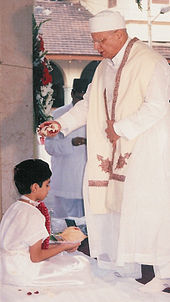Navjote
In the Zoroastrian religion, the navjote ceremony is the ritual clothing with shirt ( sedre ) and belt ( kusti ). Since the wearing of Sedre and Kusti is the identifying feature of the believer, the Navjote ritual has the character of an initiation into the religious community.
In the case of the Parsees in India , a cleansing ritual is carried out before the dressing and a confession of sin is recited, which, like the dressing itself, is performed by a priest ( mobed ). During the dressing up, the priest slips the sedre over the child and then helps him to tie the kusti for the first time . After getting dressed, the priest paints a red sign of good luck on the child's forehead, hands him lucky items from a metal tray (e.g. a coconut ), speaks blessings about the child sitting in front of him and throws rose petals , rice grains , pomegranate seeds and desiccated coconut at it . Then there is a big celebration where the child receives gifts.
In India they are dressed at the age of seven to ten, in Iran the children are a little older. The conservative Zoroastrians only dress their (male) descendants, which contributes to the decline in the number of believers there.
literature
- Michael Stausberg : Zarathustra and his religion. Beck, Munich 2005, ISBN 3-406-50870-7 , p. 10, 109-112
Web links
- The Navjote Ceremony of the Parsis - English article by Jivanji Jamshedji Modi
